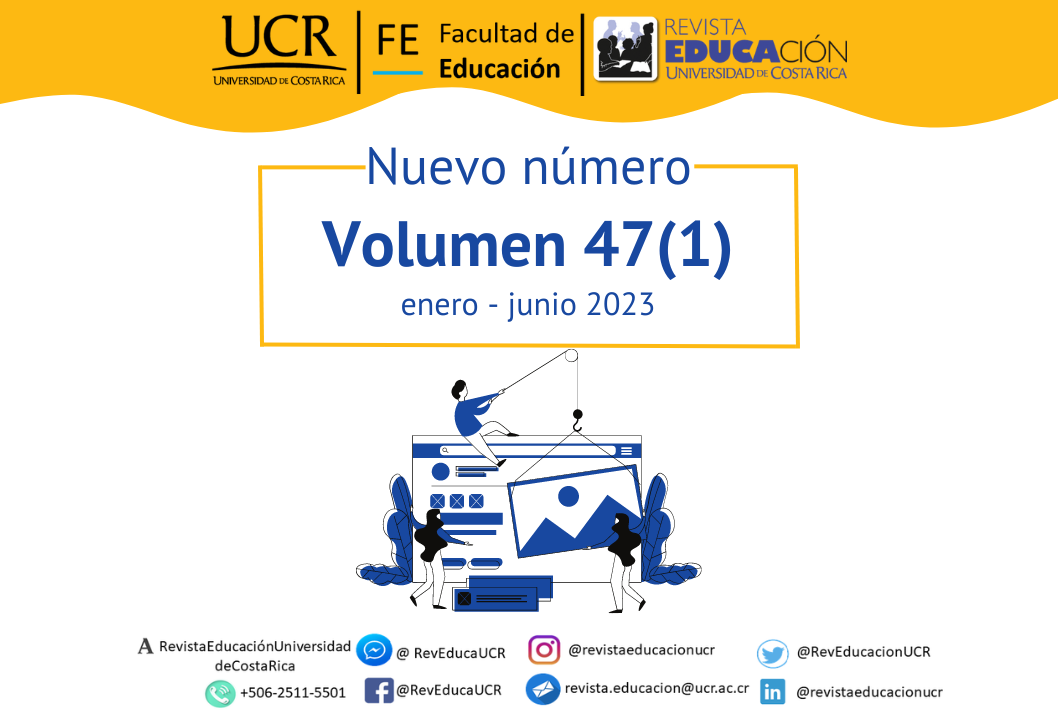Abstract
Collaborative and active learning are intrinsic to the Topography Engineering major at the University of Costa Rica. These techniques were used to design a didactic strategy that was implemented in the IT 4003 Hidrometría course. Moreover, looking to introduce students to the social and legal water resource context in the country, the didactic strategy was divided into four stages. The first one corresponded to an individual activity about the water context in Costa Rica. The second stage was a group work in which students needed to summarize the water resource legislation. Regarding the third phase, it corresponded to a role-play. Finally, the fourth stage included the feedback process. The five open questions survey was answered by the students for the feedback process. The students who participated in the activity were the ones registered in the IT-4003 Hydrometry course in the first semester of 2021. This paper shows a quantitative perspective on the implementation of the proposed didactic strategy. In general, the results were satisfactory from the student opinion and academic aspect. Moreover, the didactic strategy allowed the acquisition of important abilities around the studied topic. Furthermore, it was demonstrated that role play strengthens soft skills, which are essential to integral learning.
References
Adams, D. M., Mayer, R. E., MacNamara, A., Koenig, A. y Wainess, R. (2012). Narrative games for learning: Testing the discovery and narrative hypotheses [Juegos narrativos para el aprendizaje: Poniendo a prueba el descubrimiento y las hipótesis narrativas.]. Journal of Educational Psychology, 104(1), 235-249. https://doi.org/10.1037/a0025595
Bixio, C. (2000). Las estrategias didácticas y el proceso de mediación. En H. S. Ediciones (Ed.), Enseñar a aprender. (pp. 35-41). Homo Sapiens Ediciones.
Cantú-Hinojosa, I. (2004). El estilo de aprendizaje y la relación con el desempeño académico de los estudiantes de arquitectura de la UANL. Ciencia UANL, 7(1), 72–79. https://www.redalyc.org/pdf/402/40270113.pdf
Carreras, C. (2017). Del Homo Ludens a la gamificación. Quaderns de Filosofia, 4(1), 2341–3042. https://doi.org/10.7203/qfia.4.1.9461
Chaparro, L. (2004). Uso de los casos clínicos como estrategia didáctica en la enseñanza de anestesia. Revista Colombiana de Anestesiología, 32(4), 281–284. https://www.redalyc.org/pdf/1951/195118230007.pdf
Collazos, C. y Mendoza, J. (2006). Cómo aprovechar el “aprendizaje colaborativo” en el aula. Educación y Educadores, 9(2), 61–76. https://www.redalyc.org/pdf/834/83490204.pdf
David, J. (1997). Juegos creativos para la vida moderna. Lumen.
Delgado, M. y Solano, A. (2009). Estrategias didácticas creativas en entornos virtuales para el aprendizaje. Actualidades Investigativas en Educación, 9(2), 1–21. https://www.redalyc.org/pdf/447/44713058027.pdf
DeNeve, K. M. y Heppner, M. J. (1997). Role play simulations: The assessment of an active learning technique and comparisons with traditional lectures [Simulaciones de juego de roles: la evaluación de una técnica de aprendizaje activo y comparaciones con conferencias tradicionales]. Innovative Higher Education, 21(3), 231–246. https://doi.org/10.1007/BF01243718
Dillenbourg, P. y Baker, M. (1996, junio). Negotiation spaces in human-computer collaborative learning [Conferencia]. Second International Conference on Design if Cooperative Systems, Francia. https://www.researchgate.net/publication/228549547_Negotiation_spaces_in_human-computer_collaborative_learning
Gate-Quezada, R. (2011). El juego de roles como estrategia de evaluación de aprendizajes universitarios. Educación y Educadores, 14(2), 289–307. http://www.scielo.org.co/scielo.php?script=sci_arttext&pid=S0123-12942011000200004&lang=pt
Hanus, M. D. y Fox, J. (2015). Assessing the effects of gamification in the classroom: A longitudinal study on intrinsic motivation, social comparison, satisfaction, effort, and academic performance [Evaluación de los efectos de la gamificación en el aula: un estudio longitudinal sobre la motivación intrínseca, la comparación social, la satisfacción, el esfuerzo y el rendimiento académico]. Computers y Education, 80, 152–161. https://doi.org/10.1016/j.compedu.2014.08.019
Hidalgo, F. (2021). Propuesta de gamificación para la enseñanza y aprendizaje de técnicas de levantamiento topográfico [Tesis de Maestría, Universidad de Sevilla]. https://idus.us.es/bitstream/handle/11441/133901/TFM_MAES_HIDALGOSÁNCHEZ.pdf?sequence=1&isAllowed=y
Hierro, L., Atienza, P. y Pérez, J. (2014). Una experiencia de aprendizaje universitario mediante juegos de torneo en clase. Revista de Docencia Universitaria, 12(4), 415–436. https://riunet.upv.es/bitstream/handle/10251/137779/Hierro%3BAtienza%3BP%C3%A9rez%20-%20Una%20experiencia%20de%20aprendizaje%20universitario%20mediante%20juegos%20de%20torneo%20en%20....pdf?sequence=1&isAllowed=y
Huizinga, J. (1972). Homo ludens S. L. F. D. C. E. de España. (2da Ed.). S.L. Fondo de Cultura Económica de España.
Jiménez, C. y Puente, R. (2007). La investigación de mercados on-line: ¿realmente funciona? Debates IESA, 8(2), 20-24. https://www.researchgate.net/profile/Raquel-Puente/publication/311511072_La_investigacion_de_mercados_online_realmente_funciona/links/58499a0c08aed5252bcbe3a0/La-investigacion-de-mercados-online-realmente-funciona.pdf
Jodrell, D. I., Iveson, T. J. y Smith, I. E. (1987). Symptomatic Hypocalcaemia After Treatment with High-Dose Aminohydroxypropylidene Diphosphonate [Hipocalcemia sintomática después del tratamiento con dosis altas de difosfonato de aminohidroxipropilideno]. The Lancet, 329(8533), 622. https://doi.org/10.1016/S0140-6736(87)90255-8
Lipman, M., Sharo, A. M. y Oscanyan, F. (1992). Phlosophy in the Classroom [Filosofía en el aula]. Temple University Press.
O’Donovan, S., Gain, J. y Marais, P. (2013, 7-9 octubre). A case study in the gamification of a university-level games development course [Conferencia]. Proceedings of SAICSIT. Londres. http://pubs.cs.uct.ac.za/id/eprint/926
Oliva, H. (2016). La gamificación como estrategia metodológica en el contexto educativo universitario. Realidad y Reflexión, 44, 29-47. https://icti.ufg.edu.sv/doc/RyRN44-nOliva.pdf
Perkins, D. (2010). El Aprendizaje Pleno. Paidós.
Reese, H. (2011). The Learning-by-Doing Principle [El principio de aprender haciendo]. Behavioral Development Bulletin, 17(1), 1-19. https://doi.org/10.1037/h0100597
Retana, J. A. (2013). Reflexiones sobre los estilos de aprendizaje y el aprendizaje del cálculo para ingeniería. Actualidades Investigativas en Educación, 13(1), 1–28. https://doi.org/10.15517/aie.v13i1.11717
Rodríguez, M. (2011). La teoría del aprendizaje signigficativo: una revisión aplicable a la escuela actual. Revista Electrònica d’Investigació i Innovació Educativa i Socioeducativa, 3(1), 29-50. https://redined.mecd.gob.es/xmlui/bitstream/handle/11162/97912/rodriguez.pdf?sequence=1
Salomón, G. (1992). What does the design of effective CSCL require and how do we study its effects? [¿Qué requiere el diseño de CSCL eficaz y cómo estudiamos sus efectos?]. SIGCUE Outlook, 21(3), 62–68. https://doi.org/10.1145/130893.130909
Sánchez, M. y Rivera, I. (2019). ¿Gamificar el aula de educación superior? Análisis de expectativas sobre gamificación de estudiantes universitarios de lengua extranjera. En S. García, J. Romero, C. Rodríguez y J. Sola (Coords), Investigación, Innovación docente y TIC. Nuevos horizontes educativos (pp. 492–504). Dykinson.
Savard, A. (2015). Making Decisions about Gambling: The Influence of Risk on Children’s Arguments [Tomar decisiones sobre el juego: la influencia del riesgo en los argumentos de los niños.]. The Mathematics Enthusiast, 12(1), 226–246. https://doi.org/10.54870/1551-3440.1345
Sosa, E. (2017). Aprendizaje colaborativo mediante estuido de caso y juego de roles en el curso Análisis de las Finanzas de la Escuela de Administración de Negocios en la Universidad de Costa Rica. TEC Empresarial, 11(2), 41–53. https://revistas.tec.ac.cr/index.php/tec_empresarial/article/view/3232/2951
UNED. (2013). ¿Qué son las estrategias didácticas? Universidad Estatal a Distancia. https://www.uned.ac.cr/academica/images/ceced/docs/Estaticos/contenidos_curso_2013.pdf
##plugins.facebook.comentarios##

This work is licensed under a Creative Commons Attribution-NonCommercial-NoDerivatives 3.0 Unported License.
Copyright (c) 2022 Revista Educación - Journal of Education







